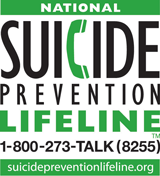Suicide: Prevention Strategies
Suicide is a serious but preventable public health problem that can have lasting harmful effects on individuals, families, and communities. While its causes are complex, the goals of suicide prevention are simple—reduce factors that increase risk and increase factors that promote resilience or coping. With a public health approach, prevention occurs at all levels of society—from the individual, family, and community levels to the broader social environment. Effective prevention strategies are needed to promote awareness of suicide while also promoting prevention, resilience, and a commitment to social change.
A public health approach to suicide prevention may be undertaken using the following resources:
Suicide Prevention Strategies
-
Preventing Suicide: A Technical Package of Policies, Programs, and Practices. [PDF 6.09MB]
This technical package is a collection of strategies that represents the best available evidence to help states and communities prevent or reduce suicide. -
National Strategy for Suicide Prevention (Department of Health and Human Services)
This revised national strategy emphasizes the role every American can play in protecting their friends, family members, and colleagues from suicide. It also provides guidance for schools, businesses, health systems, clinicians and many other sectors that takes into account nearly a decade of research and other advancements in the field since the last strategy was published. -
Strategic Direction for the Prevention of Suicidal Behavior: Promoting Individual, Family, and Community Connectedness to Prevent Suicidal Behavior [PDF 507KB]
This document describes a five-year vision for the CDC’s work to prevent fatal and nonfatal suicidal behavior. Our key strategy is promoting individual, family, and community connectedness. -
State Suicide Prevention Planning: A CDC Research Brief [PDF 4MB]
This document summarizes the results of a CDC research study conducted to describe the key ingredients of successful state-based suicide prevention planning.
Effective and Promising Programs
-
Programs and Practices: Suicide Prevention Resource Center
The Suicide Prevention Resource Center (SPRC), in collaboration with the American Foundation for Suicide Prevention, maintains the Programs and Practices. This registry, funded by the Substance Abuse and Mental Health Services Administration, identifies, reviews, and disseminates information about best practices that address specific objectives of the National Strategy for Suicide Prevention. -
SAMHSA’s National Registry of Evidence-Based Programs and Practices
The National Registry of Evidence-based Programs and Practices (NREPP) is a searchable online registry of mental health and substance abuse interventions that have been reviewed and rated by independent reviewers.
Reviews of Preventive Interventions
- Wilcox HC, Kharrazi H, Wilson RF, Musci RJ, Susukida R, Gharghabi F, Zhang A, Wissow L, Robinson KA. Data Linkage Strategies to Advance Youth Suicide Prevention: A Systematic Review for a National Institute of Health Pathways to Prevention Workshop. Ann Intern Med. 2016 Dec 6;165(11):779-785
- Brent D. Prevention Programs to Augment Family and Child Resilience Can Have Lasting Effects on Suicidal Risk. Suicide Life Threat Behav. 2016 Apr;46 Suppl 1:S39-47. doi: 10.1111/sltb.12257. Review.
- Calear AL, Christensen H, Freeman A, Fenton K, Busby Grant J, van Spijker B, Donker T. A systematic review of psychosocial suicide prevention interventions for youth. Eur Child Adolesc Psychiatry. 2016 May;25(5):467-82.
- Hom MA, Stanley IH, Joiner TE Jr. Evaluating factors and interventions that influence help-seeking and mental health service utilization among suicidal individuals: A review of the literature. Clin Psychol Rev. 2015 Aug;40:28-39.
- Joshi SV, Hartley SN, Kessler M, Barstead M. School-based suicide prevention: content, process, and the role of trusted adults and peers. Child Adolesc Psychiatr Clin N Am. 2015 Apr;24(2):353-70.
- Batterham PJ, Ftanou M, Pirkis J, Brewer JL, Mackinnon AJ, Beautrais A, Fairweather-Schmidt AK, Christensen H. A systematic review and evaluation of measures for suicidal ideation and behaviors in population-based research. Psychol Assess. 2015 Jun;27(2):501-512.
- Harrod CS, Goss CW, Stallones L, DiGuiseppi C. Interventions for primary prevention of suicide in university and other post-secondary educational settings. Cochrane Database Syst Rev. 2014 Oct 29;(10)
- Harlow AF, Bohanna I, Clough A. A systematic review of evaluated suicide prevention programs targeting indigenous youth. 2014;35(5):310-21.
- Katz C, Bolton SL, Katz LY, Isaak C, Tilston-Jones T, Sareen J; Swampy Cree Suicide Prevention Team. A systematic review of school-based suicide prevention programs. Depress Anxiety. 2013 Oct;30(10):1030-45
- Beautrais A, Fergusson D, Coggan C, Collings C, Doughty C, Ellis P, Hatcher S, Horwood J, Merry S, Mulder R, Poulton R, Surgenor L. Effective strategies for suicide prevention in New Zealand: a review of the evidence. N Z Med. 2007; 120(1251), U2459.
- Brown GK, Green KL. A review of evidence-based follow-up care for suicide prevention. American Journal of Preventive Medicine, 2014; 47(3S2):S209–S215.
- Gould MS, Greenberg T, Velting DM & Shaffer D. Youth suicide risk and preventive interventions: A review of the past 10 years. Journal of the American Academy of Child and Adolescent Psychiatry, 2003; 42:386-405.
- Krug, EG, Dahlberg, LL, Mercy, JA, Zwi, AB, and Lozano. R. (2002). Chapter 7. Self-Directed Violence. In the World Report on Violence and Health Geneva, World Health Organization [PDF 239KB].
- Mann JJ, Apter A, Bertolote J, et al. Suicide prevention strategies: a systematic review. Journal of the American Medical Association 2005; 294:2064-74.
- National Research Council. Reducing Suicide: A National Imperative. Washington, DC: The National Academies Press, 2002.
- O’Neil ME, Peterson K, Low A, Carson S, Denneson LM, Haney E, Shiroma P and Kansagara D. Suicide Prevention Interventions and Referral/Follow-up Services: A Systematic Review. VA-ESP Project #05-225; 2012.
Other Resources
-
Preventing Suicide: Program Activities Guide [PDF 443KB]
Describes CDC’s public health activities and research to prevent suicide and suicidal behavior.
Need Help? Know Someone Who Does?

Contact the National Suicide Prevention Lifeline
- Call 1-800-273-TALK (1-800-273-8255)
- Use the online Lifeline Crisis Chat.
Both are free and confidential. You’ll be connected to a skilled, trained counselor in your area.
For more information, visit the National Suicide Prevention Lifeline.
- Page last reviewed: October 3, 2017
- Page last updated: October 3, 2017
- Content source:


 ShareCompartir
ShareCompartir
